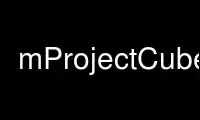
This is the command mProjectCube that can be run in the OnWorks free hosting provider using one of our multiple free online workstations such as Ubuntu Online, Fedora Online, Windows online emulator or MAC OS online emulator
PROGRAM:
NAME
mProjectCube - Reproject a single cube to a user specified scale and coordinate system
SYNOPSIS
mProjectCube [-z factor] [-d level] [-s statusfile] [-h hdu] [-x scale] [-w weightfile]
[-t threshold] [-X] [-f] in.fits out.fits hdr.template
DESCRIPTION
mProjectCube reprojects a single cube to the scale defined in a FITS header template file
(read more about header templates here). The program produces a pair of files: the
reprojected cube and an "area" image consisting of the fraction input pixel sky area that
went into each output pixel. The "drizzle" algorithm is implemented. The algorithm
proceeds by mapping pixel corners (as adjusted by drizzle, if called) from the input pixel
space to the output pixel space, calculating overlap area with each output pixel, and
accumulating an appropriate fraction of the input flux into the output cube pixels. In
addition, the appropriate fraction of the input pixel area is accumulated into the area
image pixels. Projection of points from input pixel space to output pixel space is
calculated in two steps: first map from input pixel space to sky coordinates; second map
from sky coordinates to output pixel space.
One situation that has happened often enough to warrant special note: It is possible to
define a FITS header with the reference location off the image. In particular, people
often reference cylindrical projections (e.g., CAR, CEA) to location (0.,0.) (e.g., the
Galactic center). This is not wrong in itself but does lead to extremely large pixel
offsets (e.g., in the hundreds of thousands). Related to this, if you extract a header
from an image with large offsets of this type, it is unlikely that you can simply change
projection types without also adjusting the reference location/offsets. Most likely, you
will end up with the reproject data all being off-scale.
OPTIONS
-z factor
Processing is done utilizing the drizzle algorithm. factor is a floating point
number; recommended drizzle factors are from 0.5 to 1.
-d level
Causes additional debugging information to be printed to stdout. Valid levels are
1-5 (for higher debugging levels, it is recommended to redirect the output to a
file).
-s statusfile
Output and errors are written to statusfile instead of being written to stdout.
-h hdu Use the specified FITS extension (default is to use the first HDU with image data)
-x scale
Apply a correction factor of scale to each pixel
-w weightfile
Path to a weight map to be used when reading values from the input image.
-t threshold
Pixels with weights below threshold will be treated as blank.
-X Makes the output region (originally defined in the header template) big enough to
include all of the input images
ARGUMENTS
in.fits
Input FITS file to be reprojected.
out.fits
Path of output FITS file to be created.
hdr.template
FITS header template to be used in generation of output image
RESULT
Two files are created as output: the reprojected FITS file (out.fits), and an "area" image
(out_area.fits) which records the amount of coverage (in output pixel space) provided by
the input images.
MESSAGES
OK [struct stat="OK", time=seconds]
ERROR Drizzle factor string (string) cannot be interpreted as a real number
ERROR Weight threshold string (string) cannot be interpreted as a real number
ERROR Flux scale string (string) cannot be interpreted as a real number
ERROR Cannot open status file: statusfile
ERROR HDU value (hdu) must be a non-negative integer
ERROR No overlap
ERROR Not enough memory for output data image array
ERROR Not enough memory for output area image array
ERROR Output wcsinit() failed.
ERROR Input wcsinit() failed.
ERROR FITS library error
ERROR All pixels are blank
ERROR Template file not found
ERROR Image file in.fits missing or invalid FITS
ERROR Weight file weightfile missing or invalid FITS
EXAMPLES
$ mProjectCube rawdir/real_orig.fits projdir/base_unity.fits templates/galactic_orig.txt
[struct stat="OK", time=143]
Use mProjectCube online using onworks.net services
